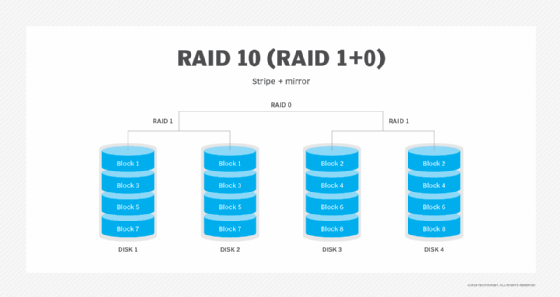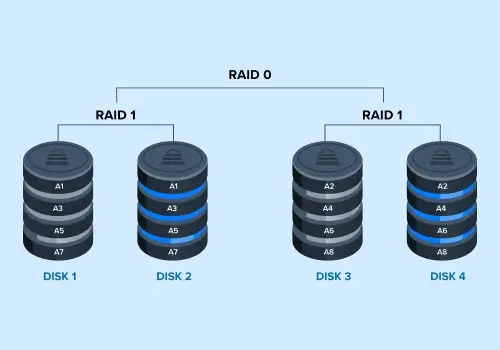Cost Analysis and Budgeting for RAID 1 and RAID 10 Implementations
RAID 1 uses mirroring to duplicate data across two drives, providing excellent data protection but effectively halving usable storage capacity. This means you pay double for usable space since every bit of data is stored twice. It requires at least two drives and offers read/write speeds comparable to a single drive, with good redundancy but no striping performance benefits.
RAID 10 (also called RAID 1+0) combines mirroring and striping by mirroring pairs of striped drives. It offers superior performance and data protection compared to RAID 1 but at a significantly higher cost because it requires at least four drives and halves usable capacity due to mirroring. RAID 10 delivers the best price-to-performance ratio for data protection but is the most expensive in terms of disk costs.
Cost Considerations
| Aspect | RAID 1 | RAID 10 |
|---|---|---|
| Minimum number of drives | 2 | 4 |
| Usable capacity | 50% of total raw capacity | 50% of total raw capacity |
| Disk cost impact | Double the disks for usable space | Double the disks for usable space, but more drives needed |
| Performance | Similar to single drive (no striping) | High performance due to striping and mirroring |
| Data protection | High (mirroring) | Very high (mirroring + striping) |
| Recovery cost (average) | Approx. $700 | Approx. $2,500 |
- Disk costs: Both RAID 1 and RAID 10 require twice the raw disk capacity to achieve usable storage due to mirroring, but RAID 10 needs more drives overall, increasing initial hardware costs.
- Performance vs cost: RAID 10 offers better performance than RAID 1 but at a higher cost due to more drives and complexity.
- Data recovery costs: RAID 10 recovery is more complex and costly (average $2,500) compared to RAID 1 (average $700), reflecting the complexity of managing both striping and mirroring during recovery.
Budgeting Implications
- RAID 1 is more budget-friendly for smaller setups needing simple mirroring and data protection with minimal performance improvement.
- RAID 10 suits environments demanding high performance and fault tolerance but requires a larger upfront investment in drives and potentially higher recovery costs.
- Additional costs to consider include RAID controller hardware, power, cooling, and maintenance.
In summary, RAID 1 offers a lower-cost entry point with solid data protection but limited performance gains, while RAID 10 provides superior performance and protection at a premium cost, requiring careful budgeting for hardware and potential recovery expenses.



















WebSeoSG offers the highest quality website traffic services in Singapore. We provide a variety of traffic services for our clients, including website traffic, desktop traffic, mobile traffic, Google traffic, search traffic, eCommerce traffic, YouTube traffic, and TikTok traffic. Our website boasts a 100% customer satisfaction rate, so you can confidently purchase large amounts of SEO traffic online. For just 40 SGD per month, you can immediately increase website traffic, improve SEO performance, and boost sales!
Having trouble choosing a traffic package? Contact us, and our staff will assist you.
Free consultation